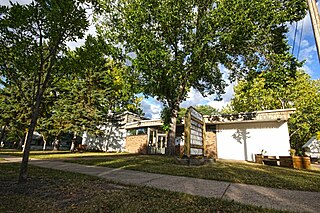Beacon Heights is a residential neighbourhood in Edmonton, Alberta, Canada that was part of the Town of Beverly before Beverly amalgamated with Edmonton in 1961.
Kenilworth is a residential neighbourhood in south east Edmonton, Alberta, Canada located just to the north of Whyte Avenue.
Terrace Heights is a roughly triangle-shaped residential neighbourhood in south east Edmonton, Alberta, Canada.
Westwood is a residential neighbourhood in north central Edmonton, Alberta, Canada. It is bounded by Yellowhead Trail to the north, 107 Street and 106 Street to the west, 118 Avenue to the south, 97 Street to the east. The Edmonton City Centre Airport is located to the west, while the Northern Alberta Institute of Technology and Kingsway Mall are located to the southwest.
Forest Heights is a residential neighbourhood in east central Edmonton, Alberta, Canada that overlooks the North Saskatchewan River valley to the north and west. Four bridges provide access to destinations on the north side of the river.
Montrose is a residential neighbourhood in north east Edmonton, Alberta, Canada.
Hazeldean is a residential neighbourhood in south east Edmonton, Alberta, Canada. The neighbourhood overlooks the Mill Creek Ravine.
Beaumaris is a residential neighbourhood in the Castledowns area of northwest Edmonton, Alberta, Canada. It is named for Beaumaris Castle in Wales.
Balwin is a residential neighbourhood in north east Edmonton, Alberta, Canada. Originally part of North Edmonton, the area was annexed by the City of Edmonton in 1912.

Ritchie is a residential neighbourhood in south east Edmonton, Alberta, Canada. It is named for Robert Ritchie, the original owner of the Ritchie Mill and former mayor of the City of Strathcona. The population of Ritchie enjoy good access to the nightlife of nearby Old Strathcona and the Mill Creek Ravine.
Empire Park is a residential neighbourhood in southwest Edmonton, Alberta, Canada. A major shopping centre, Southgate Centre, is located at the west end of the Neighbourhood.
Griesbach is a developing, award-winning, community in Edmonton, Alberta, Canada. This mainly residential neighbourhood was formerly the site of the CFB Griesbach military base and is named after William Griesbach. The land was transferred to Canada Lands Company to redevelop it. It remains a project of the Crown corporation.
King Edward Park is a residential neighbourhood on south east Edmonton, Alberta, Canada. The neighbourhood was originally annexed by Edmonton in 1912.
Calder is a residential neighbourhood in northwest Edmonton, Alberta, Canada. The area was originally part of the Hudson's Bay Company reserve and was settled by employees of the Grand Trunk Pacific Railway.
Rosslyn is a residential neighbourhood in north west Edmonton, Alberta, Canada. The neighbourhood has good access to shopping services at Northgate Centre and North Town Mall.

Prince Charles is a residential neighbourhood in north west Edmonton, Alberta. The area was named in honour of Charles III, then known as Prince Charles.
Glengarry is a residential neighbourhood located in north east Edmonton, Alberta, Canada. Northgate Centre, a major shopping mall, is located in the neighbourhood's north west corner. North Town Mall is located immediately to the north of Glengarry in the neighbourhood of Northmount.
Killarney is a residential neighbourhood located in north east Edmonton, Alberta, Canada. While the area became part of Edmonton in 1913, residential development did not occur until the 1950s and 1960s.
Kilkenny is a residential neighbourhood in north east Edmonton, Alberta, Canada. Most of the development in the neighbourhood occurred during the 1960s and 1970s. It was named after Kilkenny in Ireland.

Queen Alexandra is a mixed residential and commercial neighbourhood in south west Edmonton, Alberta, Canada. The neighbourhood, once part of the City of Strathcona, is named for Alexandra of Denmark. The north edge of the neighbourhood, along Whyte Avenue is part of Old Strathcona, a popular commercial and cultural area of Edmonton.



